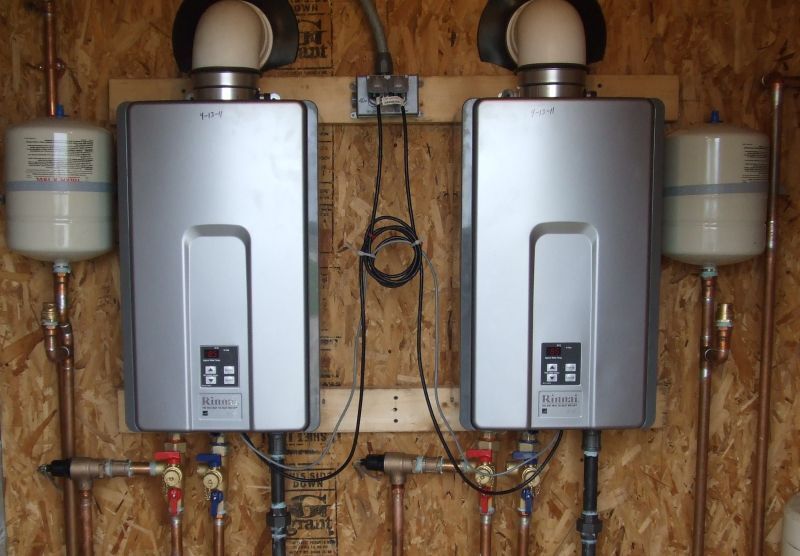Also known as on-demand water heater, tankless water heaters have been available in Canada for decades now and have been very common in Europe and Asia for much longer. Much smaller than the traditional hot water tank, they can offer reduced energy costs and continuous hot water at a precise temperature. Though they cost more to purchase, they will save you money over the long haul, and are best suited for smaller living areas where space is limited.

On-Demand Tankless Water Heater Service & Installation
How to Tell if You Need a New Water Heater
Your water heater is likely on its last legs if you notice…
- You run out of hot water to soon
- Your water does not come up to temperature
- Water leaking around the unit
- Rust or sediment can be seen in your hot water
We provide 24-hour emergency service to ensure that your hot water is back to normal as quickly as possible in the event of a problem.
Makes and Models We install
Tankless Water Heaters

Water Heater Maintenance
Water heaters are typically out of sight and out of mind. However, they do require regular maintenance in order to provide long life and reduced energy costs.
If you live in the Central Okanagan, we can set up an annual maintenance program that will keep your water hot and your costs low for many years.
Installation and Replacement
On Demand Water Heater Service & Installation
Shamrocks Plumbing and Heating is your Central Okanagan source for all things related to hot water heater problems. Count on us for guaranteed work at competitive rates.
Tankless Water Heating
Tankless water heaters — also called instantaneous, continuous flow, inline, flash, on-demand, or instant-on water heaters — are water heaters that instantly heat water as it flows through the device, and do not retain any water internally except for what is in the heat exchanger coil. Copper heat exchangers are preferred in these units because of their high thermal conductivity and ease of fabrication.
Tankless heaters may be installed throughout a household at more than one point-of-use (POU), far from or without a central water heater, or larger centralized whole house models may still be used to provide all the hot water requirements for an entire house. The main advantages of tankless water heaters are a plentiful, practically limitless continuous flow of hot water (as compared to a limited flow of continuously heated hot water from conventional tank water heaters), and potential energy savings under some conditions due to the use of energy only when in use, and the elimination of standby energy losses since there is no hot water tank.
The main disadvantage of these systems are their high initial costs (equipment and installation). The proper maintenance is needed for every water heater for the long-life of them.You can fix simple problems through DIY methods, however, lack of professional knowledge can lead to short circuits, line breaks, and even personal harm through burns by sudden spurts of boiling water.
Point-of-use (POU) Water Heaters
Point-of-use (POU) tankless water heaters are located immediately where the water is being used, so the water is almost instantly hot, which reduces water wastage. POU tankless heaters also can save more energy than centrally installed tankless water heaters, because no hot water is left in lengthy supply pipes after the flow is shut off. However, POU tankless water heaters are often installed in combination with a central water heater, since the former type have usually been limited to under 6 litres/minute (1.5 US gallons/minute), which is sufficient for only light usage. In many situations, the initial expense of buying and installing a separate POU heater for every kitchen, laundry room, bathroom, and sink can outweigh the money saved in water and energy bills. In the US, POU water heaters until recently were almost always electrical, and electricity is often substantially more expensive than natural gas or propane (when the latter fuels are available).
In recent years, higher-capacity tankless heaters have become more widely available, but their feasibility may still be limited by the infrastructure's ability to furnish energy (maximum electrical amperage or gas flow rate) fast enough to meet peak hot water demand. In the past, tank-type water heaters have been used to compensate for lower energy delivery capacities, and they are still useful when the energy infrastructure may have a limited capacity, often reflected in peak demand energy surcharges.
In theory, tankless heaters can always be somewhat more efficient than storage tank water heaters. In both kinds of installation (centralized and POU), the absence of a tank saves energy compared to conventional tank-type water heaters, which have to reheat the water in the tank as it cools off while waiting for use (this is called "standby loss"). In some installations, the energy lost by a tanked heater located inside a building merely helps to heat the occupied space. This is true for an electric unit, but for a gas unit some of this lost energy leaves through the exhaust vent. However, if at any time the building must be cooled to maintain comfortable temperatures, the heat lost from a hot water tank located in the conditioned space must be removed by the air conditioning system, thus requiring larger cooling capacity and energy usage.
With a central water heater of any type, any cold water standing in the pipes between the heater and the point-of-use is dumped down the drain as hot water travels from the heater. This water wastage can be avoided if a recirculator pump is installed, but at the cost of the energy to run the pump, plus the energy to reheat the water recirculated through the pipes. Some recirculating systems reduce standby loss by operating only at select times—turning off late at night, for example. This saves energy at the expense of greater system complexity.
When it comes time to replace a failing water heater and you have questions about your best choice, call us for more information. There are a lot of variables that may sway your decision one way or the other.
Call today, we will be happy to discuss your options.
Send us a message
We will get back to you as soon as possible
Please try again later
Head Office

About Us

Shamrocks Plumbing and Heating
Open 24 Hours
(250) 575-8138
